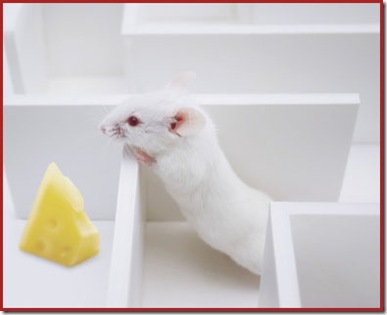It seems that businesses think loyalty is for sale. Loyalty programs are everywhere. Spend enough money with a business and you get rewarded with free stuff like a $10 certificate toward your next purchase. While shopping this next week, it’s highly likely you will either participate in one, or be offered to enroll in such a program. But these aren’t really loyalty programs, they’re frequency programs. My problem with them is not with the semantics, it’s with the focus.
Loyalty is an emotion, emotions are created by the brand and the customer experience, not incentives. These frequency programs are really the mouse/cheese principle in action: “you navigate the maze, I’ll give you some cheese.” You just have to hope the mouse doesn’t find more cheese in a different maze or you have to start offering more cheese. Eventually, you get involved in a cheese war.
That’s what happened in the airline industry when Texas International Airlines (now part of Continental) introduced the first frequent-flyer program in 1979. Every time you flew with Texas International they would give you a little bit of cheese. Accumulate enough and you could trade that cheese in for a free flight. That was all well and good until American Airlines introduced their frequent flyer program in 1981, followed quickly by Continental, United, Delta and British Airways. Each of those airlines had enormous storehouses and there was cheese flying all over the place. The mice were happy because they could fly any airline and get some cheese. This leveled the maze and so the airlines started expanding their cheese distribution to credit cards, hotels, even restaurants.
Eventually, there were so many ways to get free cheese that it became a cost burden for the airlines. So they responded with tighter restrictions, making it more difficult to get rewarded. The mice, used to getting fed well, began jumping from maze to maze, wondering where all the cheese went. But something else happened too. Frequent flyer programs were no longer loyalty programs, they were now games, contests of sorts, a battle of wits and wills between the mice and the airlines; customers trying to maneuver the maze of air miles getting the free flights they felt they deserved, and airlines trying to creatively find ways to offer less cheese.
What is a Real Loyalty Program?
Marketer Drew McLellan writes of so-called loyalty programs, saying that they are “all the rage right now.” Drew relates a personal experience with the TGIFridays loyalty program, saying;
“The McLellans are a big fan of TGIFridays. (part of that is because the West Des Moines location has the best waitress I’ve ever known…but that’s a different blog post)”
This may be the only time I ever disagree with Drew, but I think it’s the same blog post. Would Drew be as loyal to TGIFriday’s without the best waitress he’s ever known? Or would he simply be a frequent visitor because of the restaurant’s frequency program, susceptible to be lured away by other, more lucrative frequency programs? Would he leave TGIFriday’s for more cheese?
Frequency programs are necessary in the absence of customer loyalty. Customer loyalty is an emotion awarded by customers who feel emotionally attached to a business. Those emotions are stoked by the customer’s experience with that business. Perhaps businesses should should stop spending so much money on frequency program cheese, and start spending more on enhancing the customer experience. The customer experience is the real loyalty program.
Do you have a loyalty program or a frequency program? Please add your comment below.
If you liked this article, consider subscribing. For updates on new articles: Receive The Marketing Spot by Email or Get The Marketing Spot in a blog reader


[…] Customer Loyalty Programs, Frequency Programs, and Cheese Customer Loyalty and the 100% Solution The Customer Loyalty Investment […]